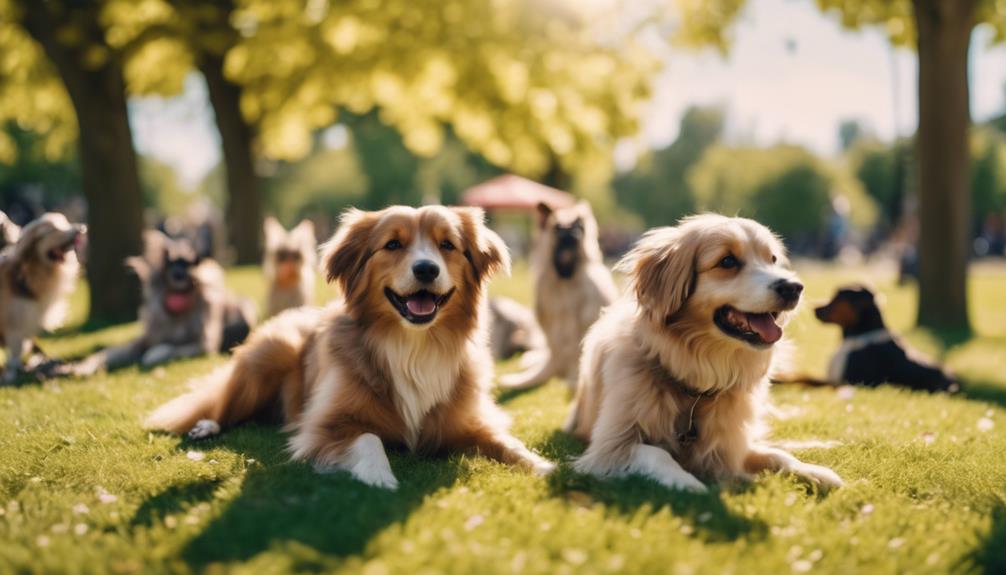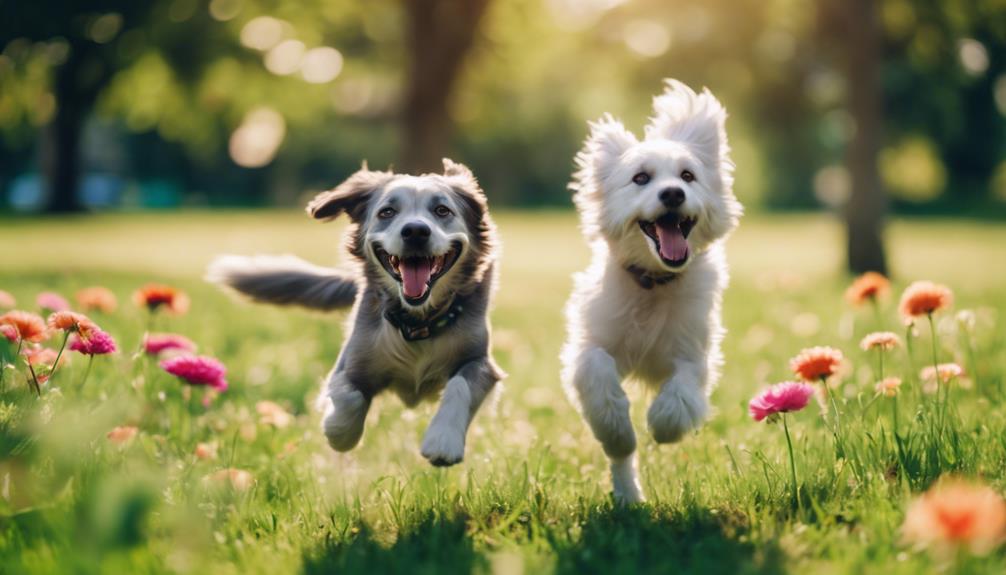Understanding the intricate relationship between exercise and a dog's temperament is essential for any responsible pet owner. Implementing a well-structured exercise regimen can not only enhance your dog's physical health but also significantly improve their behavior and emotional well-being. From tailored exercise routines to socialization opportunities, there are numerous strategies to consider. However, the nuances of each approach can vary widely depending on individual factors such as breed and energy levels. What are the most effective methods to ensure your dog thrives both mentally and physically? The following insights may provide clarity.
Understand Corgi Energy Levels

Corgis are known for their high energy levels and playful demeanor, which necessitates regular exercise to ensure their physical and mental well-being.
Understanding corgi personality traits is essential for effective care. These dogs are intelligent, friendly, and often eager to please, which can make them enthusiastic participants in various activities.
Their exercise needs are significant; a lack of physical activity can lead to behavioral issues such as excessive barking or chewing. Daily walks, playtime, and interactive games are crucial in meeting these needs.
Engaging in activities that challenge their minds, such as puzzle toys, is also beneficial. Providing this exercise not only promotes a healthier lifestyle but also enhances their overall temperament, ensuring a happy and balanced corgi.
Choose the Right Exercise
Choosing the right exercise for your dog is essential for their health and happiness.
Tailored exercise routines, which consider your dog's age, breed, and energy level, help ensure they receive the appropriate amount of physical activity.
Additionally, incorporating interactive playtime activities can enhance their mental stimulation, making exercise a fun and engaging experience for both you and your pet.
Tailored Exercise Routines
Determining the most suitable exercise routine for your dog requires careful consideration of their individual needs, energy levels, and physical abilities.
Tailored exercise routines can significantly enhance your dog's temperament, offering numerous behavioral benefits. For instance, high-energy breeds may thrive with daily runs or agility training, while older or less active dogs might benefit from leisurely walks or gentle play.
To maximize effectiveness, consider the frequency of exercise; consistent routines encourage stability and help to manage excess energy.
Aim for a balance of intensity and duration that suits your dog's temperament. By observing your dog's reactions and adjusting the exercise frequency, you can foster a healthier, happier companion while improving their overall behavior and well-being.
Interactive Playtime Activities
Selecting the right interactive playtime activities can significantly enhance your dog's physical fitness and mental stimulation, fostering a deeper bond between you and your pet.
Engaging in fetch games is an excellent way to promote cardiovascular health while satisfying your dog's natural instinct to chase. This activity encourages agility and can be tailored to your dog's energy level.
Additionally, tug of war is another interactive option that builds strength and provides a fun outlet for energy. This game encourages teamwork and reinforces the human-dog relationship.
When choosing between these activities, consider your dog's preferences and physical abilities. Prioritizing interactive playtime will not only improve your dog's temperament but also create lasting memories for both of you.
Incorporate Daily Walks

Incorporating daily walks into your dog's routine is essential for their physical and mental well-being.
Establishing a consistent schedule not only helps your dog anticipate their exercise time but also fosters a sense of security.
Establish a Routine
Establishing a consistent routine that includes daily walks is essential for maintaining your dog's physical and mental well-being. A structured schedule helps your dog anticipate their daily exercise, which can reduce anxiety and promote calm behavior.
During these walks, utilize positive reinforcement by rewarding your dog with treats or praise for good behavior, such as walking without pulling on the leash. This approach not only enhances your dog's experience but also fosters behavioral consistency.
Over time, your dog will learn expected behaviors during walks, making the experience enjoyable for both of you. Remember, regular exercise contributes significantly to your dog's overall temperament, leading to a happier and healthier companion.
Aim for walks at the same time each day to reinforce this routine.
Vary Your Routes
To keep your dog engaged and excited about daily walks, it is essential to vary your routes and explore new environments together. This not only enhances their physical activity but also stimulates their mental well-being.
Consider incorporating scenic routes that offer beautiful views, such as parks or nature trails. These settings provide diverse smells and sights, keeping your dog curious and alert.
Alternatively, urban exploration can introduce your dog to different sounds and sights, such as bustling streets or local markets. Changing your walking routine can prevent boredom and reduce behavioral issues.
Encourage Social Interaction
Encouraging social interaction during daily walks is crucial for enhancing your dog's social skills and overall well-being. Regular walks provide an excellent opportunity for your dog to meet other dogs and people, helping them develop confidence and friendliness.
Visiting dog parks is a great way to facilitate these interactions, as they are designed for safe play and socialization.
Additionally, consider organizing playdates with other dogs. This allows your dog to form bonds in a controlled environment, promoting positive experiences.
Remember to observe your dog's body language during these interactions; it is essential to ensure they are comfortable.
Engage in Playtime Activities
Incorporating playtime activities into your dog's routine not only fosters physical fitness but also enhances mental stimulation and strengthens the bond between pet and owner.
Engaging in fetch games is a great way to encourage your dog to run and retrieve, providing excellent cardiovascular exercise. This game also helps improve your dog's agility and focus.
Another beneficial activity is tug of war, which promotes interactive play and allows your dog to use their strength in a fun way. This activity can enhance your dog's problem-solving skills and teach them about boundaries.
Remember to use safe toys during these activities to prevent injury.
Regular playtime enriches your dog's life, contributing to a well-rounded temperament and improved behavior.
Explore Mental Stimulation

Mental stimulation is essential for dogs, as it not only alleviates boredom but also promotes cognitive development and overall well-being. Engaging your dog in mentally stimulating activities can significantly enhance their temperament.
Consider incorporating the following activities into your routine:
- Puzzle toys: These interactive toys challenge your dog to think and problem-solve, keeping their mind sharp.
- Scent games: Hide treats around your home or yard, encouraging your dog to use their natural sniffing abilities to find them.
Try Obstacle Courses
Obstacle courses offer a fun and engaging way to exercise your dog while also promoting their physical and mental well-being.
By incorporating various challenges, such as jumps, tunnels, and weave poles, you can create a stimulating environment that encourages your dog to think and move actively.
In the following sections, we will explore the benefits of obstacle courses and provide guidance on designing your own course to suit your dog's needs and abilities.
Benefits of Obstacle Courses
Engaging your dog in obstacle courses offers numerous physical and mental benefits that enhance their overall well-being and strengthen the bond between you and your pet.
These activities encourage exercise and stimulate your dog's mind through creative obstacles. By navigating through various challenges, your dog develops agility, coordination, and confidence.
- Builds trust and strengthens your relationship
- Provides a fun way to burn off excess energy
While setting up these courses, always prioritize safety considerations, ensuring that the obstacles are appropriate for your dog's size and skill level.
This not only prevents injuries but also ensures a positive experience, making obstacle courses an excellent choice for both physical and emotional development.
Designing Your Course
Creating an effective obstacle course requires careful planning and consideration of your dog's abilities to ensure a challenging yet achievable experience.
Start by evaluating your dog's size, energy level, and skill set. Use various training techniques to introduce different obstacles, such as jumps, tunnels, and weave poles. Begin with simple tasks and gradually increase difficulty as your dog gains confidence.
Incorporate behavior reinforcement to encourage positive responses. Reward your dog with treats or praise when they successfully navigate an obstacle.
Ensure the course is safe and free of hazards. Regularly change the layout to maintain your dog's interest and motivation.
Utilize Socialization Opportunities

Socialization opportunities play a crucial role in enhancing a dog's physical and mental well-being, promoting positive behaviors and reducing anxiety in various environments. Engaging in activities like visiting dog parks and setting up playdates can significantly improve your dog's temperament.
Increased confidence in unfamiliar situations
Improved social skills with other dogs and humans
Reduced behavioral issues stemming from anxiety
Monitor Exercise Duration
Monitoring exercise duration is essential for ensuring that your dog receives the appropriate amount of physical activity tailored to their age, breed, and overall health.
It is important to balance exercise intensity with rest periods to prevent overexertion. Dogs, like humans, can become fatigued, so it is crucial to monitor fatigue signs such as excessive panting, drooling, or reluctance to continue.
To effectively manage exercise duration:
- Set a routine that includes both playtime and walks.
- Limit high-intensity activities to 20-30 minutes for younger dogs and adjust based on their energy levels.
Adjust for Weather Conditions

Adjusting exercise routines for varying weather conditions is crucial to maintaining your dog's health and well-being.
Weather adaptations are necessary to ensure your dog remains safe and comfortable during outdoor activities. Seasonal considerations can greatly impact your dog's exercise, and being mindful of these factors is essential.
Hot weather: Shorten walks and provide plenty of water to prevent overheating.
Cold weather: Use dog jackets for warmth and limit time outdoors to avoid frostbite.
Rainy or windy days: Consider indoor activities like fetch or agility courses to keep your dog engaged.
Celebrate Achievements Together
Acknowledging your dog's progress and accomplishments in their exercise routine fosters a strong bond and motivates continued engagement in physical activities.
It is essential to celebrate milestones, whether it's completing a new distance or mastering a new trick. These moments can be recognized with simple rewards, such as treats, praise, or additional playtime.
To effectively reward achievements, consider the following:
- Use treats: Offer a special snack for significant milestones.
- Increase playtime: Extend play sessions as a reward for consistent effort.

